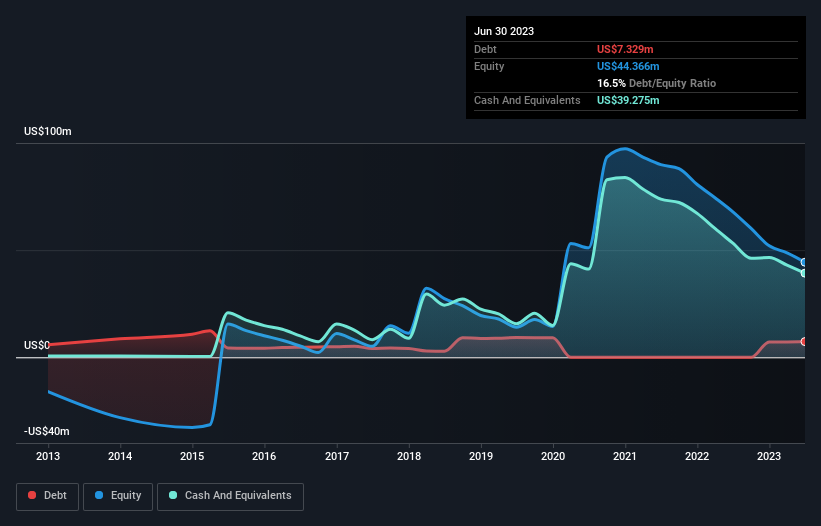Some say volatility, rather than debt, is the best way to think about risk as an investor, but Warren Buffett famously said that 'Volatility is far from synonymous with risk.' When we think about how risky a company is, we always like to look at its use of debt, since debt overload can lead to ruin. We note that Profound Medical Corp. (TSE:PRN) does have debt on its balance sheet. But the more important question is: how much risk is that debt creating?
When Is Debt A Problem?
Debt assists a business until the business has trouble paying it off, either with new capital or with free cash flow. In the worst case scenario, a company can go bankrupt if it cannot pay its creditors. However, a more common (but still painful) scenario is that it has to raise new equity capital at a low price, thus permanently diluting shareholders. Of course, plenty of companies use debt to fund growth, without any negative consequences. When we examine debt levels, we first consider both cash and debt levels, together.
Check out our latest analysis for Profound Medical
How Much Debt Does Profound Medical Carry?
You can click the graphic below for the historical numbers, but it shows that as of June 2023 Profound Medical had US$7.33m of debt, an increase on none, over one year. However, it does have US$39.3m in cash offsetting this, leading to net cash of US$31.9m.

How Strong Is Profound Medical's Balance Sheet?
According to the last reported balance sheet, Profound Medical had liabilities of US$11.0m due within 12 months, and liabilities of US$1.46m due beyond 12 months. Offsetting these obligations, it had cash of US$39.3m as well as receivables valued at US$6.59m due within 12 months. So it can boast US$33.4m more liquid assets than total liabilities.
This surplus suggests that Profound Medical is using debt in a way that is appears to be both safe and conservative. Given it has easily adequate short term liquidity, we don't think it will have any issues with its lenders. Succinctly put, Profound Medical boasts net cash, so it's fair to say it does not have a heavy debt load! When analysing debt levels, the balance sheet is the obvious place to start. But it is future earnings, more than anything, that will determine Profound Medical's ability to maintain a healthy balance sheet going forward. So if you're focused on the future you can check out this free report showing analyst profit forecasts.
In the last year Profound Medical had a loss before interest and tax, and actually shrunk its revenue by 2.5%, to US$6.8m. We would much prefer see growth.
So How Risky Is Profound Medical?
Statistically speaking companies that lose money are riskier than those that make money. And in the last year Profound Medical had an earnings before interest and tax (EBIT) loss, truth be told. Indeed, in that time it burnt through US$23m of cash and made a loss of US$29m. However, it has net cash of US$31.9m, so it has a bit of time before it will need more capital. Overall, its balance sheet doesn't seem overly risky, at the moment, but we're always cautious until we see the positive free cash flow. When analysing debt levels, the balance sheet is the obvious place to start. However, not all investment risk resides within the balance sheet - far from it. For example, we've discovered 2 warning signs for Profound Medical that you should be aware of before investing here.
When all is said and done, sometimes its easier to focus on companies that don't even need debt. Readers can access a list of growth stocks with zero net debt 100% free, right now.
New: Manage All Your Stock Portfolios in One Place
We've created the ultimate portfolio companion for stock investors, and it's free.
• Connect an unlimited number of Portfolios and see your total in one currency
• Be alerted to new Warning Signs or Risks via email or mobile
• Track the Fair Value of your stocks
Have feedback on this article? Concerned about the content? Get in touch with us directly. Alternatively, email editorial-team (at) simplywallst.com.
This article by Simply Wall St is general in nature. We provide commentary based on historical data and analyst forecasts only using an unbiased methodology and our articles are not intended to be financial advice. It does not constitute a recommendation to buy or sell any stock, and does not take account of your objectives, or your financial situation. We aim to bring you long-term focused analysis driven by fundamental data. Note that our analysis may not factor in the latest price-sensitive company announcements or qualitative material. Simply Wall St has no position in any stocks mentioned.
About TSX:PRN
Profound Medical
Operates as a commercial-stage medical device company that develops and markets incision-free therapeutic systems for the image guided ablation of diseased tissue in Canada, Germany, the United States, and Finland.
High growth potential with mediocre balance sheet.
Similar Companies
Market Insights
Community Narratives



